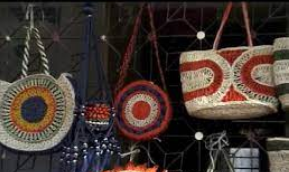The Kumbhakar potters of Panchmuravillage in Bankura, district Bishnupur are renowned for their skill in crafting terracotta products. They are particularly well known for the ‘Bankura horse.
The Bishnupur district is world famous for itsterracotta temples of builtby the Malla Kings in the 17th and 18th century, archaeological digs have unearthed terracotta artefactsin the nearby Sushunia hillock that date the crafts back to pre-historic times.
There are around 450 craftspersons in Panchmura and its surrounding villages of Bibardha and Sendra who continue to live and follow their traditional practice in the Kumbhakar Para.(2018)
The terracottaobjects made here were traditionally offered to village deitieslike Dharma Thakur, Manasa and others whileofferings for wish fulfilment were also made on the tombs of Muslim Saints.
While still used as offering they are now largely used in urban settings as decorations. Finished objects can be seen in the KumbhakarPara in the verandas and homes of the potters. Using the red clay available in and around the village, the famous long-necked Bankura Horses, the elephants, figures of deities and other objects are arranged according to the size, the large sized at the back are graded so that the tiniest ones are in the front.The sizesranging 7 feet to 4”
The process of making starts with the removal of impurities in the clay by the potters, with sand and khar/rice paddy hay is added to bind the clay firmly. The kneading of the clay id done both with the hands and feet sometimes taking up to 6 hours
The objects are created using a combination of a manual wheel and moulding.The work is gender based with wheel work being designated to the male members. The wheel is used to build the main parts of the object – the rounded cylindrical and funnel shapes. The wheel, made locally,is of wood, in a diameterof 3-4 feet. Besides blades basic tools crafted out of bamboo, called chiari and local wood are used to etch on the motifs. These are crafted by the potters to suit their own requirements. The other tools include the stone beater/balyathat is used to smooth and strengthen the inner walls and surfaces, while the wood beater/pitna of about 4×10 “is used for beating and shaping the outer surfaces. The patara/plank of wood is used to roll the clay coils used in decorating objects
While hand-moulding continues to be practiced, readymade plaster- of-Paris moulds are also used for snake-heads and other parts.
The decorative work is done by the women using the most simple of tools like the chirari ofbamboo. The objects are sun-dried and then coloured with natural earth colours before kiln firing. These colours are white/khadigad, yellow/bhalogad and brown. This too is done by the women.
Firing depends on the number of objects that are ready and can be either once a fortnight or once a month. The traditional kiln usually being a circular one
As there is a large demand form urban areas special care is taken in packaging these breakable objects. Using paddy-hay and newspaper are as a protective layer, the ear and the tail (depending on the object) are added last. Easy to access, the closest railway station Bishnupur is just 45 minutes from Panchmura while from Kolkattait is about a 5 hour drive.
Gallery
YOUR VIEWS
PRACTITIONERS: INDIA
Access 70,000+ practitioners in 2500+ crafts across India.
BIBLIOGRAPHY
10,000+ listings on arts, crafts, design, heritage, culture etc.
GLOSSARY
Rich and often unfamiliar vocabulary of crafts and textiles.
SHOP at India InCH
Needs to be written.






